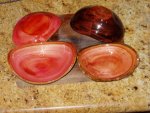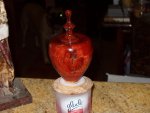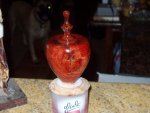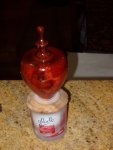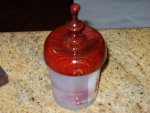Dan Mosley
Member
- Messages
- 1,169
- Location
- Palm Springs, Ca
I called Mohawk the other day and talked to a technical rep about their product and the problems I was having spraying it. He explained to me that Mohawk is Acetone based and to spray it effectively you have a 2-3hr window of time to add additional coats that should burn in. After that there will probably be layering issues.
Also said that it would be best (for woodturning and art objects etc..)to use one of there string instrument lacquers because of a higher solids content ( 90 or something like that ) whereas the others do not. The string instrument lacquer would produce the glass like finish (less durable but nicer finish achieved easily). I was complaining about not being able to get with the Mohawk WW.
Further, I probably should have not bought this type of lacquer - and that not all lacquers are made equal <----------no kidding
Comment:::: "Geeeee....you think they may have wanted to educate your sales people on this information before selling it with alot of false promises........
His final suggestion after I said that i guess ill probably get rid of it because the Campbell is working well was to use it for dipping.
Comment:::::Nope, I think ill just dispose of it and chalk it up to a hard lesson learned.............
Below are some smaller projects I used to try out my spraying ability. They turned out well and I figured out a way to correct some flaws when you spray. If you get some sag or pinhole bubbles or whatever you call them I just let it dry for a bit and they spray it with lacque thinner and watch the magic..............
Also said that it would be best (for woodturning and art objects etc..)to use one of there string instrument lacquers because of a higher solids content ( 90 or something like that ) whereas the others do not. The string instrument lacquer would produce the glass like finish (less durable but nicer finish achieved easily). I was complaining about not being able to get with the Mohawk WW.
Further, I probably should have not bought this type of lacquer - and that not all lacquers are made equal <----------no kidding
Comment:::: "Geeeee....you think they may have wanted to educate your sales people on this information before selling it with alot of false promises........
His final suggestion after I said that i guess ill probably get rid of it because the Campbell is working well was to use it for dipping.
Comment:::::Nope, I think ill just dispose of it and chalk it up to a hard lesson learned.............
Below are some smaller projects I used to try out my spraying ability. They turned out well and I figured out a way to correct some flaws when you spray. If you get some sag or pinhole bubbles or whatever you call them I just let it dry for a bit and they spray it with lacque thinner and watch the magic..............

